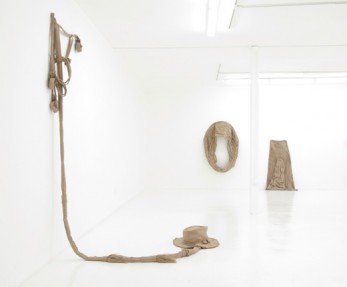My several earlier visits to Miami were more motivated by sunlight than art, so any prior perspectives on the city were built upon a platform of ignorance mixed with objectivity. As such, these thoughts of a Northern visiting writer emerged from three cloudlessly enjoyable days in late April — an enlightening opportunity to sample (in very affable and erudite company) the city’s thriving cultural scene.
Since objectivity so embarrassingly often gives the slip to those who speak in its name, I’m happy to propose the following as fantasy: there was a moment in which Miami visual artists had an opportunity to participate in giving form to that subterranean, amorphous, slippery Thing that makes a city distinct. Some would call this Thing a city’s identity.
In George Sánchez-Calderón’s version of history, the conquistadors, hitherto pleased with the trade winds pulling them across the Atlantic, would be caught in an inexplicable yet suicidal traffic jam somewhere off the coast of Miami. The ships would still be there today.
In Sweden, amidst a right wing government and budget cuts in cultural sectors, Tensta Konsthall Director and Curator Maria Lind launched an exhibition that brought heated debates about art and the economy to the fore. Like many European countries, especially those in Scandinavia, Sweden has had a fairly well-sponsored cultural sector powered by economic prosperity and social democratic politics.
Although this sprawling show treads close to self-parodying the avant-garde, underground, and their attendant deviances, it ultimately succeeds in unraveling something in the viewer’s sensibility untouched since the excesses of the late New York school.
As part of Hannes Bend’s first solo exhibition in Miami, he dredged up nearly a hundred tires from the failed Osborne Artificial Reef off the coast of Fort Lauderdale. Begun in 1972, the Osborne Reef is composed of between one and two million discarded car tires that were supposed to foster aquatic life that sport fishing was decimating, but this never happened.
Out of Place features ten sculptural wall works constructed almost entirely out of burlap. As a distinct shift in practice for Gast, this new body of work was conceived through an intuitive process of exchanges, meditations, and transformations in and around the artist’s studio.







